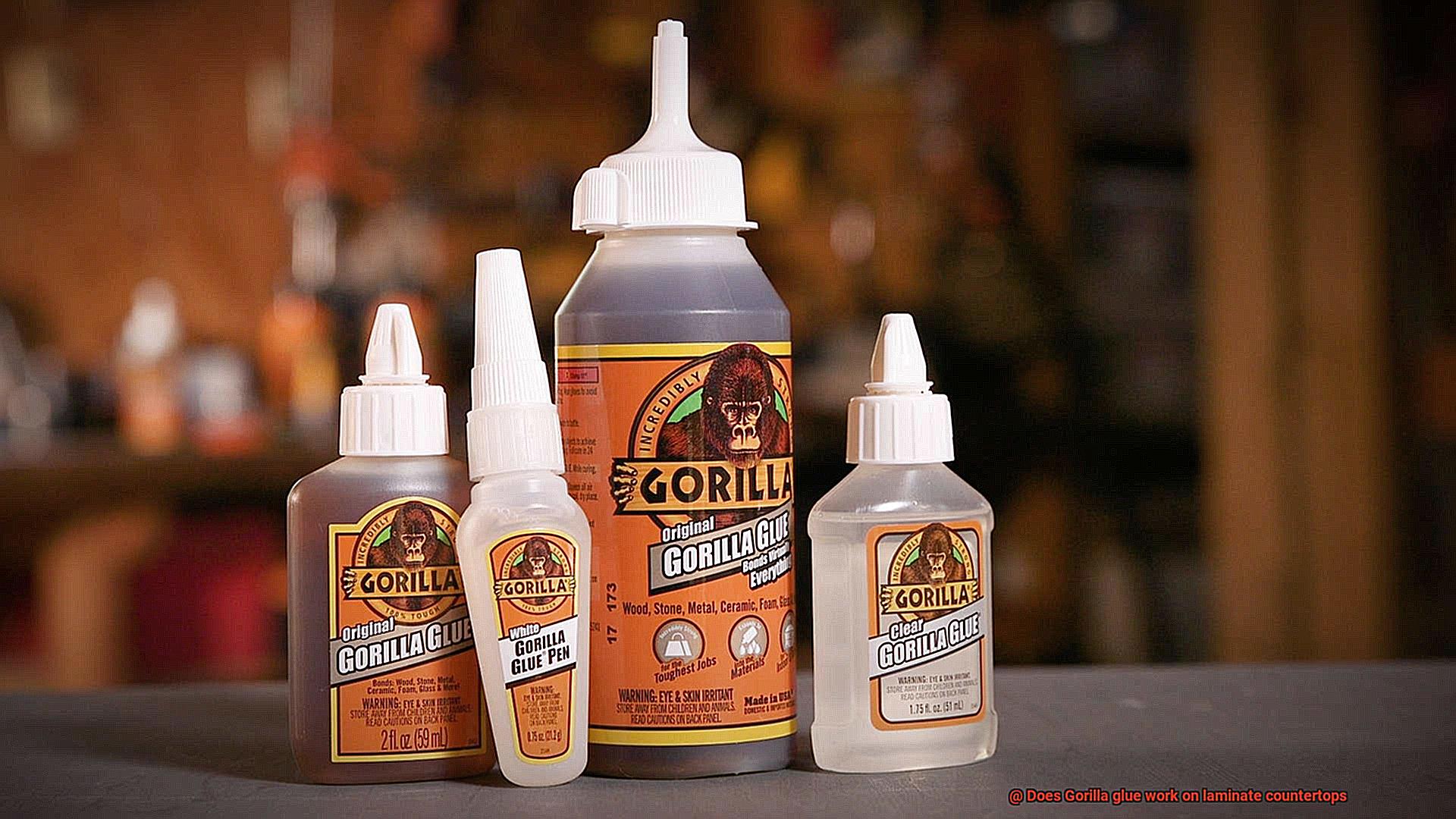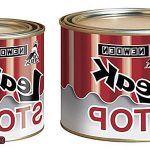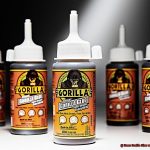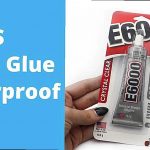Got a laminate countertop that’s giving you headaches? Maybe it’s a stubborn corner that won’t stay put or a joint that needs some serious reinforcement. When it comes to adhesives, Gorilla Glue is like the superhero of the DIY world – known for its powerful bonding capabilities and versatility. But here’s the million-dollar question: does Gorilla Glue really work its magic on laminate countertops?
Before we jump into the nitty-gritty, let’s take a moment to understand why Gorilla Glue has become such a fan favorite. This stuff is no ordinary adhesive. It’s a polyurethane-based formula that expands as it cures, creating an unbreakable bond. From fixing broken furniture to patching up household items, Gorilla Glue has earned its reputation as a reliable go-to for all kinds of DIY projects.
Now, imagine you’re in your kitchen, staring at that pesky piece of laminate countertop misbehaving right before your eyes. You’ve heard whispers about Gorilla Glue being the ultimate problem solver – promising strength, durability, and long-lasting results. But can it really live up to the hype?
In this deep dive, we’re going to uncover whether Gorilla Glue is truly up to the challenge of securing your laminate countertop. We’ll explore its unique qualities, different application methods, and even discuss specific scenarios where it may shine or stumble. So if you’re itching for some expert advice on fixing laminate countertops like a pro, stick around (pun intended) as we unveil the truth about Gorilla Glue’s performance on this particular surface.
Ready to find out if Gorilla Glue is your secret weapon for countertop repairs? Let’s get started.
Advantages of Using Gorilla Glue for Laminate Countertops
Contents
- 1 Advantages of Using Gorilla Glue for Laminate Countertops
- 2 Disadvantages of Using Gorilla Glue for Laminate Countertops
- 3 Other Adhesives Suitable for Laminate Countertops
- 4 How to Apply Contact Cement on Laminate Countertops
- 5 Tips for Ensuring a Strong Bond with Contact Cement
- 6 Alternatives to Gorilla Glue for Laminate Countertops
- 7 Pros and Cons of Alternative Adhesives
- 8 Conclusion
Laminate countertops are a popular choice for kitchens and bathrooms due to their durability and resistance to moisture and stains. When it comes to bonding or repairing laminate countertops, choosing the right adhesive is crucial. In this article, we will explore the advantages of using Gorilla Glue for laminate countertops and why it is an excellent choice for homeowners.
Advantage 1: Unbeatable Bonding Capability
Gorilla Glue is renowned for its strong bonding capabilities. It forms a reliable and durable bond that can withstand the demands of everyday use. With Gorilla Glue, you can have peace of mind knowing that your laminate countertops will stay securely in place.
Advantage 2: Waterproof Protection
One of the main advantages of Gorilla Glue for laminate countertops is its waterproof properties. Laminate countertops are frequently exposed to moisture, spills, and water splashes in kitchens and bathrooms. Gorilla Glue’s waterproof bond helps protect the laminate from water damage, ensuring longevity and maintaining the countertop’s aesthetic appeal.
Advantage 3: Temperature Resistance
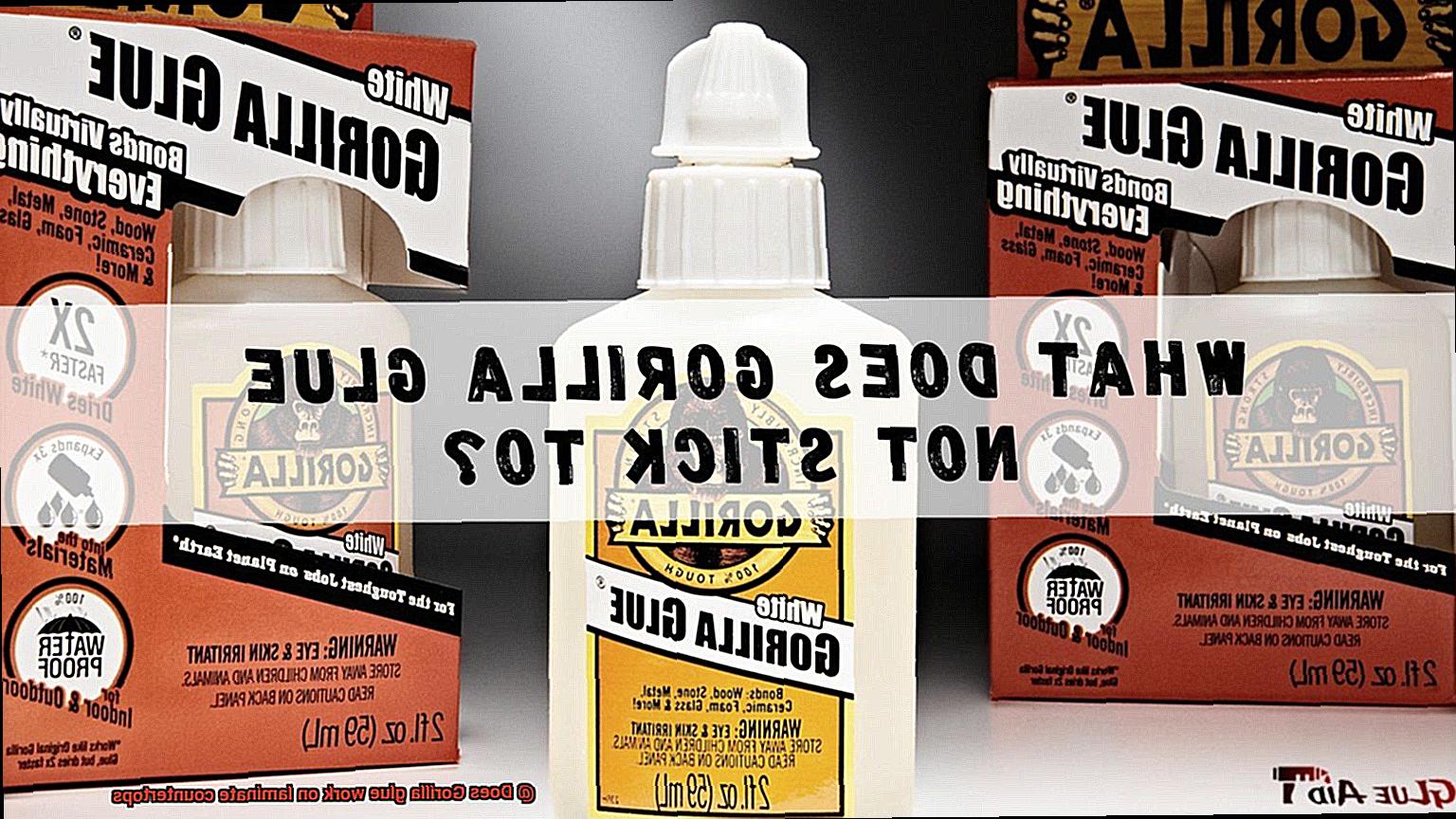
Laminate countertops can expand and contract with changes in temperature, which can weaken or compromise the adhesive bond. However, Gorilla Glue is resistant to temperature fluctuations, making it a reliable choice for laminate countertops. This resistance ensures that the bond remains intact even in extreme temperature conditions.
Advantage 4: Versatility at its Best
Gorilla Glue offers exceptional versatility as it can be used on various materials commonly found in laminate countertops such as wood, metal, stone, and plastic. This versatility makes it a convenient option for repairing or bonding different components of laminate countertops, providing flexibility for any project.
Advantage 5: Easy to Use
Gorilla Glue is user-friendly and requires minimal preparation. It comes in different forms, such as liquid glue or glue sticks, allowing users to choose the most suitable option for their specific needs. Additionally, Gorilla Glue has a fast curing time, enabling users to complete their countertop projects efficiently.
Advantage 6: Aesthetic Appeal
When it comes to aesthetics, Gorilla Glue provides a transparent bond that remains virtually invisible once dried. This ensures that the glued areas do not stand out or affect the overall appearance of the laminate countertop. You can achieve a seamless and professional finish with Gorilla Glue.
Advantage 7: Strength and Durability
Lastly, Gorilla Glue offers excellent strength and durability. It can withstand heavy loads and resist impacts, making it an ideal choice for high traffic areas where laminate countertops are prone to frequent use and potential damage. With Gorilla Glue, you can be confident that your laminate countertops will remain intact for years to come.
Disadvantages of Using Gorilla Glue for Laminate Countertops
Choosing the right adhesive for laminate countertops is essential for a secure and long-lasting bond. While Gorilla Glue is highly regarded, it may not be the best option for this application. In this post, we will explore the disadvantages of using Gorilla Glue for laminate countertops.
Expansion:
Gorilla Glue’s tendency to expand as it cures is a major drawback. This expansion can lead to messy seepage, resulting in an unsightly appearance. It can also create uneven surfaces and gaps, compromising the overall aesthetic appeal.
Lack of Waterproofing:
Laminate countertops are exposed to moisture and water splashes in kitchens and bathrooms. Unfortunately, Gorilla Glue is not waterproof, making it susceptible to breaking down over time when exposed to moisture. This weakens the bond between the laminate and countertop surface, leading to potential lifting or peeling.
Moisture Activation:
Gorilla Glue requires moisture to activate and cure properly. However, laminate countertops are not designed to withstand moisture exposure. When exposed to moisture, the wood particle core can swell, warp, or become damaged, rendering it incompatible with Gorilla Glue application.
Difficult Repairs and Modifications:
Gorilla Glue’s exceptional strength makes future repairs or modifications challenging. Removing or replacing a section of laminate without damaging the countertop surface becomes a formidable task.

Lengthy Curing Time:
Gorilla Glue takes 24 hours or more to fully cure. This extended curing time can be inconvenient when you need to complete a project quickly and start using your countertop as soon as possible.
Other Adhesives Suitable for Laminate Countertops
When it comes to laminate countertops, choosing the right adhesive is essential for a secure and long-lasting bond. While Gorilla Glue may be a popular choice for various DIY projects, it is not the best option for laminate countertops. Fortunately, there are other adhesives specifically formulated for this purpose that provide exceptional strength and durability.
One such adhesive is contact cement. Widely used in the installation and repair of laminate countertops, contact cement offers a strong bond that is resistant to water, heat, and chemicals. Its ease of application and ability to create a secure bond make it a preferred choice for many professionals.
Another adhesive worth considering is construction adhesive. This type of adhesive is designed for bonding large surfaces, making it ideal for laminate countertops. With its ability to withstand the daily wear and tear of a busy kitchen or bathroom, construction adhesive provides a durable bond that ensures your countertop will last for years to come.
For those seeking a strong and moisture-resistant bond, epoxy resin adhesives are an excellent option. Known for their exceptional strength and resistance to moisture, heat, and chemicals, epoxy resins create a bond that can withstand the demands of a laminate countertop.
It is important to note that when selecting an adhesive for laminate countertops, it is crucial to choose one specifically designed for this purpose. Using the wrong adhesive can result in weak or failed bonds, potentially damaging the countertop. Therefore, it is advisable to follow the manufacturer’s instructions carefully, including the appropriate application method, curing time, and any necessary safety precautions.
Before applying any adhesive, thorough preparation of the laminate countertop surface is essential. This involves cleaning the surface thoroughly and removing any dirt, grease, or old adhesive residue to ensure optimal bonding.
How to Apply Contact Cement on Laminate Countertops
Laminate countertops are a popular choice for kitchens and bathrooms due to their durability and easy maintenance. When it comes to joining or repairing laminate countertops, using the right adhesive is crucial for a strong and long-lasting bond. In this comprehensive guide, we will take you through the process of applying contact cement on laminate countertops, ensuring a professional finish that will stand the test of time.
Step 1: Prepare the Surface
Before applying contact cement, it is essential to prepare the laminate countertop surface. Clean it thoroughly, removing any dust, grease, or debris that could hinder proper adhesion. A mild detergent and water solution followed by thorough drying with a clean cloth will ensure a clean surface ready for bonding.
Step 2: Gear Up and Ventilate
To protect your hands and lungs from potential irritation, wear gloves and work in a well-ventilated area. Contact cement can have a strong smell, so it’s crucial to take precautions for a safe application.
Step 3: Apply the Contact Cement
Using a brush or roller, apply a thin and even coat of contact cement onto both the laminate countertop surface and the backside of the laminate sheet. Be sure to follow the manufacturer’s instructions regarding drying time and application thickness. The contact cement will provide an initial tackiness that allows for repositioning during bonding.
Step 4: Allow for Drying Time
After applying the contact cement, allow it to dry for the specified amount of time indicated on the product label. During this drying period, do not touch or disturb the surfaces that have been coated with contact cement.
Step 5: Bond the Laminate Sheet
Once the drying time has passed, carefully align the edges and corners of the laminate sheet with the countertop surface. Starting from one end, gradually press down the laminate sheet onto the surface, ensuring a smooth and even bond. Apply firm and consistent pressure to eliminate any air bubbles or wrinkles.
Step 6: Trim and Clean Up
If there are any excess areas of laminate sticking out beyond the countertop edges, use a router or a sharp utility knife to trim them off. Be cautious not to damage the countertop surface while trimming. Lastly, clean off any excess adhesive using a suitable solvent as recommended by the manufacturer for a clean and professional finish.
Tips for Ensuring a Strong Bond with Contact Cement
When it comes to bonding laminate countertops, using the right adhesive is crucial for ensuring a strong and durable bond. While Gorilla glue may be a popular choice for many DIY projects, it may not be suitable for laminate countertops due to its expanding nature and yellowish color. In this guide, we will explore the importance of using contact cement, a laminate-specific adhesive, and provide tips to ensure a strong bond and maintain the aesthetic appeal of your laminate countertops.
Clean and Prepare the Surfaces:
Before applying contact cement, it is essential to clean and prepare the surfaces properly. Any dirt, grease, or debris on the countertop or the material you are bonding it to can hinder the adhesive’s effectiveness. Use a mild detergent and water to clean the surfaces thoroughly, then dry them completely. This step ensures that the adhesive can adhere effectively and create a strong bond that will withstand daily use.
Choose the Right Adhesive:
Using an adhesive specifically designed for laminate countertops is crucial to avoid any damage or discoloration. Gorilla glue may expand as it dries, which can lead to warping or distortion of the laminate surface. Additionally, its yellowish color can be unsightly on light-colored or white laminate surfaces. Opt for contact cement that is formulated for laminated materials to ensure a strong bond without compromising the visual appeal of your countertops.
Apply an Even Coat of Contact Cement:
To achieve a strong bond, apply an even coat of contact cement to both surfaces using a brush or roller. It is important to follow the manufacturer’s instructions regarding drying times and recommended coverage rates. Applying too much or too little adhesive can result in weak spots in the bond or adhesive failure. Take your time and ensure that the entire surface area is covered evenly for maximum bonding strength.
Press Firmly and Allow Sufficient Curing Time:
Once the contact cement has dried to the touch, carefully align the surfaces and press them together firmly. Use a roller or apply pressure evenly across the entire surface to ensure a strong bond. It is important not to move or disturb the surfaces for at least 24 hours to allow the adhesive to fully cure. This curing time allows the contact cement to bond securely and provide long-lasting durability.
Regular Maintenance and Care:
To maintain the strength of the bond over time, it is important to practice regular maintenance and care for your laminate countertops. Avoid using harsh or abrasive cleaners that can weaken the bond. Instead, use mild soap and water to clean the surface regularly. If any damage or separation occurs, it is possible to re-bond the surfaces using additional contact cement. However, it is recommended to seek professional assistance if significant repairs are needed.
Alternatives to Gorilla Glue for Laminate Countertops
When it comes to laminating countertops, there are alternatives to Gorilla Glue that may be a better fit for your needs. While Gorilla Glue is known for its strength and versatility, it may not always be the ideal choice for laminate surfaces due to its expanding properties and potential damage.
One alternative adhesive option is contact cement. This adhesive is commonly used in the installation of laminate countertops because it provides a strong bond and is resistant to moisture. Perfect for those kitchen spills and splashes. However, it’s important to carefully follow the manufacturer’s instructions as the application process can vary.
Another alternative is epoxy adhesive. Known for its high strength and durability, epoxy adhesives can bond different materials, including laminate countertops, with excellent results. Just be sure to choose an epoxy adhesive that is suitable for laminates and follow the instructions closely.
For those seeking a heavy-duty solution, construction adhesive might be the way to go. Designed for tough jobs, construction adhesives provide a strong bond that can withstand the demands of a busy kitchen. Just make sure to select one that is compatible with laminate countertops and follow the recommended application process.
If you prefer a simpler option, double-sided adhesive tapes can also do the trick. These tapes have a strong adhesive on both sides and can securely bond your laminate countertop to other surfaces. Just be sure to choose a tape specifically designed for laminates and properly prepare your surface before applying.
Pros and Cons of Alternative Adhesives
When it comes to laminate countertops, traditional adhesives like Gorilla glue may not always be the best option. That’s where alternative adhesives come in, offering unique benefits and drawbacks. Let’s explore the pros and cons of alternative adhesives for laminate countertops.
One superhero of adhesives is epoxy resin. Known for its exceptional bonding properties, it provides a strong and long-lasting bond that can withstand the daily wear and tear of a busy kitchen. Epoxy resin is an excellent choice for laminate countertops.
Another option is contact cement, acting as a shield against moisture and spills. When two surfaces are pressed together, contact cement forms a strong bond that stands the test of time. It’s ideal for joining laminate sheets during installation.
For those seeking a tough guy to tackle any kitchen demand, construction adhesive is the way to go. With a strong initial tack and bonding properties, it confidently secures various surfaces, including laminate countertops.
While alternative adhesives offer advantages, limitations should be considered. Some may require specific application techniques or additional tools, increasing complexity. Compatibility with the specific type of laminate material is crucial to ensure a strong bond.
Additionally, alternative adhesives may come with a higher price tag compared to traditional options like Gorilla glue, increasing the overall project cost.
ycLnwJ2Tfec” >
Conclusion
In conclusion, Gorilla Glue can be a game-changer when it comes to laminate countertops. Its unbeatable bonding capability, waterproof protection, and temperature resistance make it a top contender in the adhesive world. Plus, its versatility and ease of use make it a dream for DIY enthusiasts.
Not only does Gorilla Glue get the job done, but it also adds a touch of aesthetic appeal to your countertops. With its strength and durability, you can trust that your laminate will stay securely in place for years to come.
However, like any superhero, Gorilla Glue has its weaknesses. Its expansion during curing can lead to some messy situations and uneven surfaces. And while it’s tough as nails once cured, it’s not completely waterproof, so moisture exposure over time could cause damage.
Another thing to consider is that Gorilla Glue requires moisture to activate and cure properly. This might not play well with the wood particle core of laminate countertops. And let’s not forget about its exceptional strength – while impressive, it can make future repairs or modifications quite challenging.
But fear not. If Gorilla Glue isn’t your cup of tea for laminate countertop projects, there are alternative adhesives on the market. Contact cement is a popular choice due to its strong bond and resistance to water and heat. Epoxy resin adhesives offer exceptional strength and resistance to moisture, heat, and chemicals. And if you’re working with large surfaces in a bustling kitchen or bathroom, construction adhesive is your go-to option.
When selecting an adhesive for your laminate countertop project, remember to choose one specifically designed for this purpose. Follow the manufacturer’s instructions diligently regarding application methods, curing time, and safety precautions. And don’t forget about proper surface preparation – it’s crucial for optimal bonding.
Ultimately, whether you go with Gorilla Glue or opt for an alternative adhesive boils down to your unique needs and preferences. Take the time to weigh the advantages and disadvantages of each option before making your final decision.

